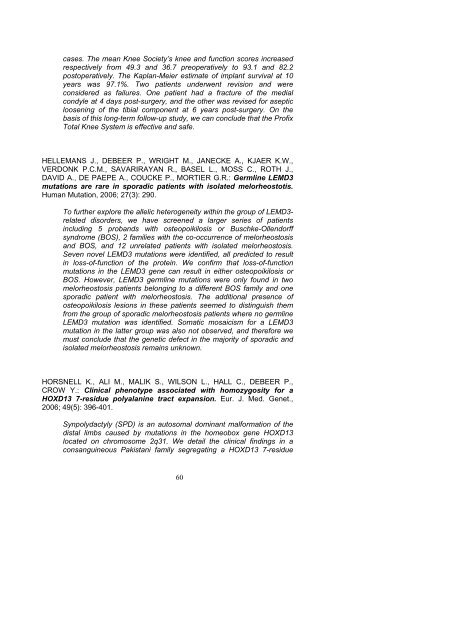2006 - UZ Leuven
2006 - UZ Leuven
2006 - UZ Leuven
Create successful ePaper yourself
Turn your PDF publications into a flip-book with our unique Google optimized e-Paper software.
cases. The mean Knee Society’s knee and function scores increasedrespectively from 49.3 and 36.7 preoperatively to 93.1 and 82.2postoperatively. The Kaplan-Meier estimate of implant survival at 10years was 97.1%. Two patients underwent revision and wereconsidered as failures. One patient had a fracture of the medialcondyle at 4 days post-surgery, and the other was revised for asepticloosening of the tibial component at 6 years post-surgery. On thebasis of this long-term follow-up study, we can conclude that the ProfixTotal Knee System is effective and safe.HELLEMANS J., DEBEER P., WRIGHT M., JANECKE A., KJAER K.W.,VERDONK P.C.M., SAVARIRAYAN R., BASEL L., MOSS C., ROTH J.,DAVID A., DE PAEPE A., COUCKE P., MORTIER G.R.: Germline LEMD3mutations are rare in sporadic patients with isolated melorheostotis.Human Mutation, <strong>2006</strong>; 27(3): 290.To further explore the allelic heterogeneity within the group of LEMD3-related disorders, we have screened a larger series of patientsincluding 5 probands with osteopoikilosis or Buschke-Ollendorffsyndrome (BOS), 2 families with the co-occurrence of melorheostosisand BOS, and 12 unrelated patients with isolated melorheostosis.Seven novel LEMD3 mutations were identified, all predicted to resultin loss-of-function of the protein. We confirm that loss-of-functionmutations in the LEMD3 gene can result in either osteopoikilosis orBOS. However, LEMD3 germline mutations were only found in twomelorheostosis patients belonging to a different BOS family and onesporadic patient with melorheostosis. The additional presence ofosteopoikilosis lesions in these patients seemed to distinguish themfrom the group of sporadic melorheostosis patients where no germlineLEMD3 mutation was identified. Somatic mosaicism for a LEMD3mutation in the latter group was also not observed, and therefore wemust conclude that the genetic defect in the majority of sporadic andisolated melorheostosis remains unknown.HORSNELL K., ALI M., MALIK S., WILSON L., HALL C., DEBEER P.,CROW Y.: Clinical phenotype associated with homozygosity for aHOXD13 7-residue polyalanine tract expansion. Eur. J. Med. Genet.,<strong>2006</strong>; 49(5): 396-401.Synpolydactyly (SPD) is an autosomal dominant malformation of thedistal limbs caused by mutations in the homeobox gene HOXD13located on chromosome 2q31. We detail the clinical findings in aconsanguineous Pakistani family segregating a HOXD13 7-residue60

















